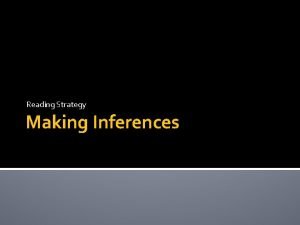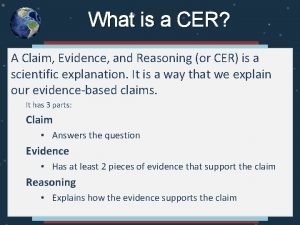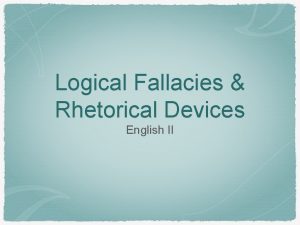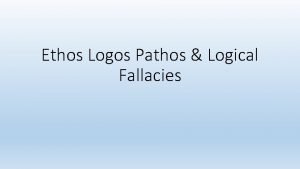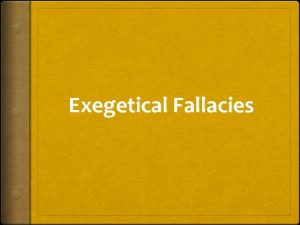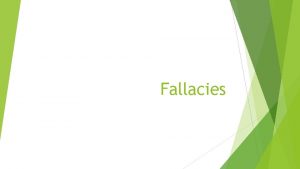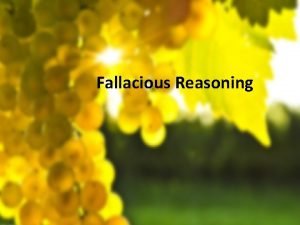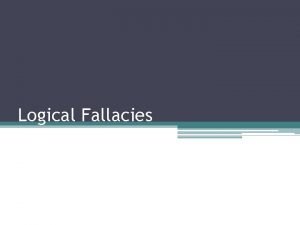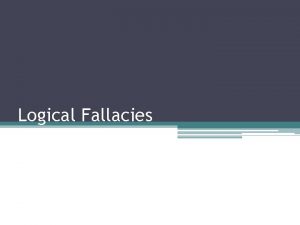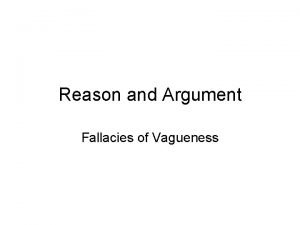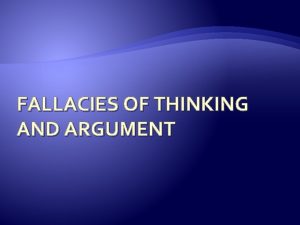Today Evaluating Reasoning Reasoning and Evidence Fallacies Evidence











- Slides: 11

Today • Evaluating Reasoning • Reasoning and Evidence Fallacies • Evidence • Discuss the midterm and review

Quasilogial arguments: arguments that imply a formal syllogistic structure (deductive) Categorical syllogisms: – all A is B – C is A – therefore C is B Disjunctive syllogisms: – either A or B – not A – therefore B Counter-strategies – draft these out as full syllogism to identify weak points – in categorical syllogisms, you can attack the holistic nature of the category – in disjunctive syllogisms, you can attack the binary choice

analogy: because two objects resemble each other in known ways, they will also resemble each other in unknown respects Literal analogies: compare two objects of the same class in order to reveal an unknown – X has attributes A, B, C, and D – Y has attributes A, B, and C – Therefore Y will probably demonstrate D as well Figurative analogies: compare two objects of different classes – X has attributes A, B, C – Y is like X – Therefore Y will probably demonstrate A, B, and C Counter-strategies: question the degree of similarity – quality: X and Y’s similarities do not support your conclusion – quantity: while x and y are similar in this regard they are more often dissimilar – produce counter-examples

generalization: what is true of certain members of a class will also be true for other members or for the class as a whole. arguments from example: since this example holds true, the class holds true (inductive) – A is B – A is a member of X – Therefore X is B Counter strategies: question the relationship of the part to the whole – Quality: question the accuracy of the example: does this example warrant your conclusion? • C is also a member of X, yet C is not B – Quantity: question the representativeness of the example • C, D, E, F, G, H are all members of X and are not B, therefore A is not the norm – produce counter-examples

Cause: a cause or groups of causes brings about a specific effect. Necessary condition must be present for the effect to result, but it is not the cause. – A is necessary for B to occur (but does not directly cause B) Sufficient condition causes the effect. – A causes B Counter strategies: questions the consequential relationship – Quality: attack the nature of the cause-effect relationship • Does A always produce B? – Quantity: can other causes trigger a similar effect? • C can cause also cause B – produce counter-examples

coexistential: deduction from an observed trait to an unobserved trait Structure – I see A – A implies the existence of B – therefore B exists Counter-strategies – quality: is the relationship between seen and unseen consistent and reciprocal? Can we move back and forth within this argument? • Does A always imply the existence of B? • Does the existence of B always coincide with the presence of A? – Quantity: is there enough A to really suggest the presence of B? – produce counter-examples

Dissociation: decouple one concept from another Structure – A is not B – A is better than B Counter-strategies – A is B – B is not always or necessarily better than A – produce counter-examples

Reasoning Fallacies • Post hoc – A occurred after B, therefore A is the cause of B • Slippery slope – If A occurs, all hell will break loose • Single-cause – A caused B (when B was caused by A, B, C, D, etc. )

Evidence fallacies • Begging the question – A is the cause of B, therefore B is the result of A • Non sequitur – A is true because of X (where X has nothing directly to do with A)

Evidence • • Reliability Expertise Objectivity Consistency – External consistency: the source matches up with other sources – Internal consistency: the source remains consistent • • Recency Relevance Access Accuracy

List the top 5 most credible sources. 1. 2. 3. 4. 5. 6. 7. 8. 9. 10. 11. 12. 13. 14. 15. 16. 17. Rowling, J. K. (1997). Harry Potter and the Sorcerer’s Stone. New York: Scholastic Inc. Sports Illustrated The official website of the White House. The Tonight Show with Jay Leno Ideda, K. & Huckfeldt, R. (2001). Political communication and disagreement among citizens in Japan and the United States. Political Behavior, 23(1), 23 -51. An interview with President George W. Bush, dated September 11 th, 2001. An interview with Crystal Gould [my roommate in college] dated November 10 th, 2002. The Old Testament. The Koran. The Book of Morman. The New York Times The Daily Newsweek Playboy The official website of Buffy the Vampire Slayer Nova [PBS sponsored television show]
 For todays meeting
For todays meeting We are going today
We are going today Proposal kickoff meeting agenda
Proposal kickoff meeting agenda Fingerprint galton details
Fingerprint galton details Today's lesson or today lesson
Today's lesson or today lesson Example of repitition
Example of repitition Difference of inductive and deductive reasoning
Difference of inductive and deductive reasoning Argument by analogy
Argument by analogy A conclusion reached on the basis of evidence and reasoning
A conclusion reached on the basis of evidence and reasoning What is cer?
What is cer? Are logical fallacies rhetorical devices
Are logical fallacies rhetorical devices Ethos logos pathos quiz
Ethos logos pathos quiz








